Organisation Functions: Analysis of Organisation Types and Structures
VerifiedAdded on 2020/10/22
|17
|5124
|164
Report
AI Summary
This report provides a comprehensive analysis of organizational functions, exploring different types of organizations such as public, private, and voluntary sectors, and their respective legal structures, sizes, and scopes. It delves into the relationship between organizational structures, including flat, tall, and line structures, and their functions in achieving organizational goals. The report uses LEGO as a case study to illustrate these concepts, examining its organizational structure and how it aligns with its functions. Furthermore, the report analyzes the impact of the macro environment on business operations through a PESTEL analysis of LEGO, evaluating political, economic, social, technological, environmental, and legal factors. It also includes a SWOT analysis to determine the strengths, weaknesses, opportunities, and threats of specific businesses in relation to external macro factors, providing a holistic view of organizational dynamics and strategic planning.
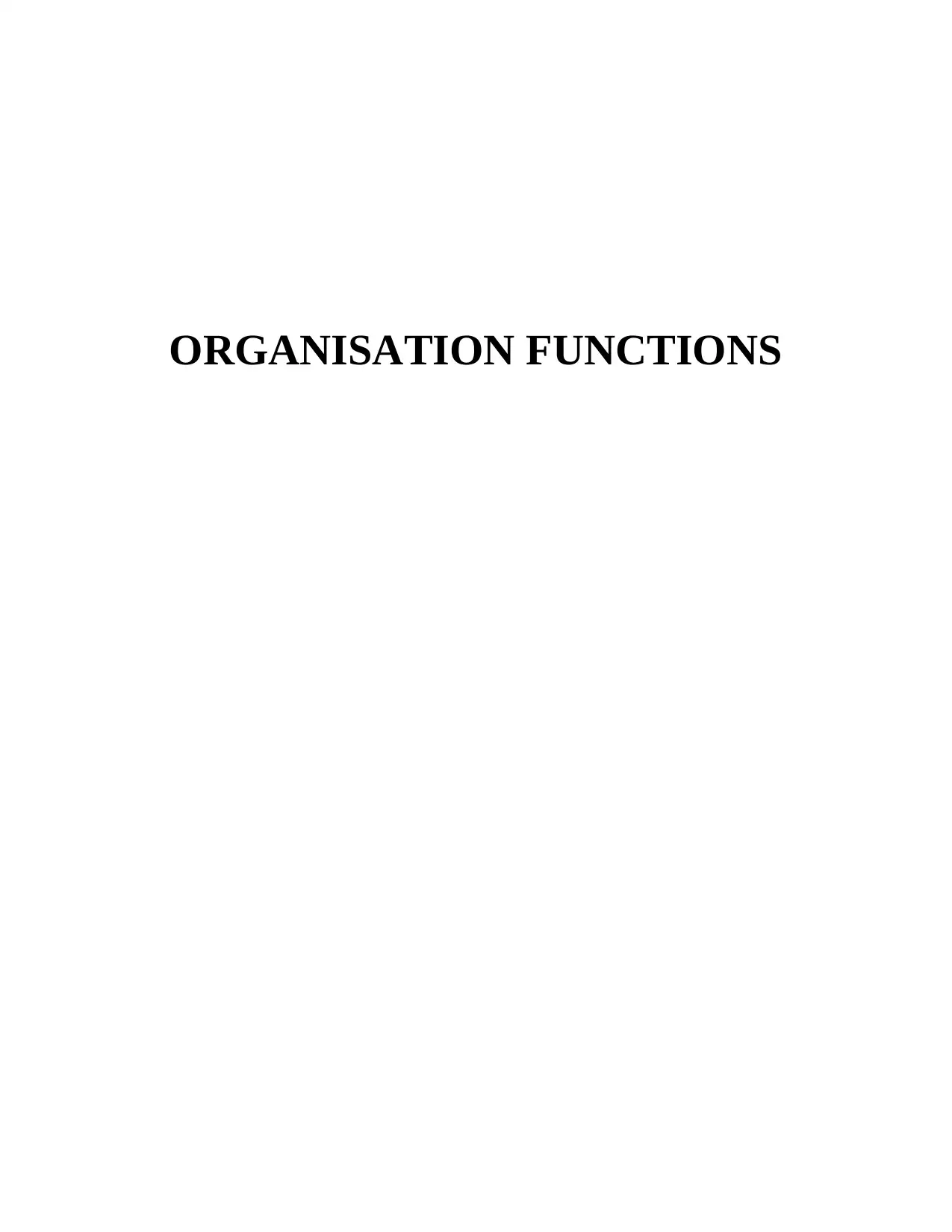
ORGANISATION FUNCTIONS
Paraphrase This Document
Need a fresh take? Get an instant paraphrase of this document with our AI Paraphraser
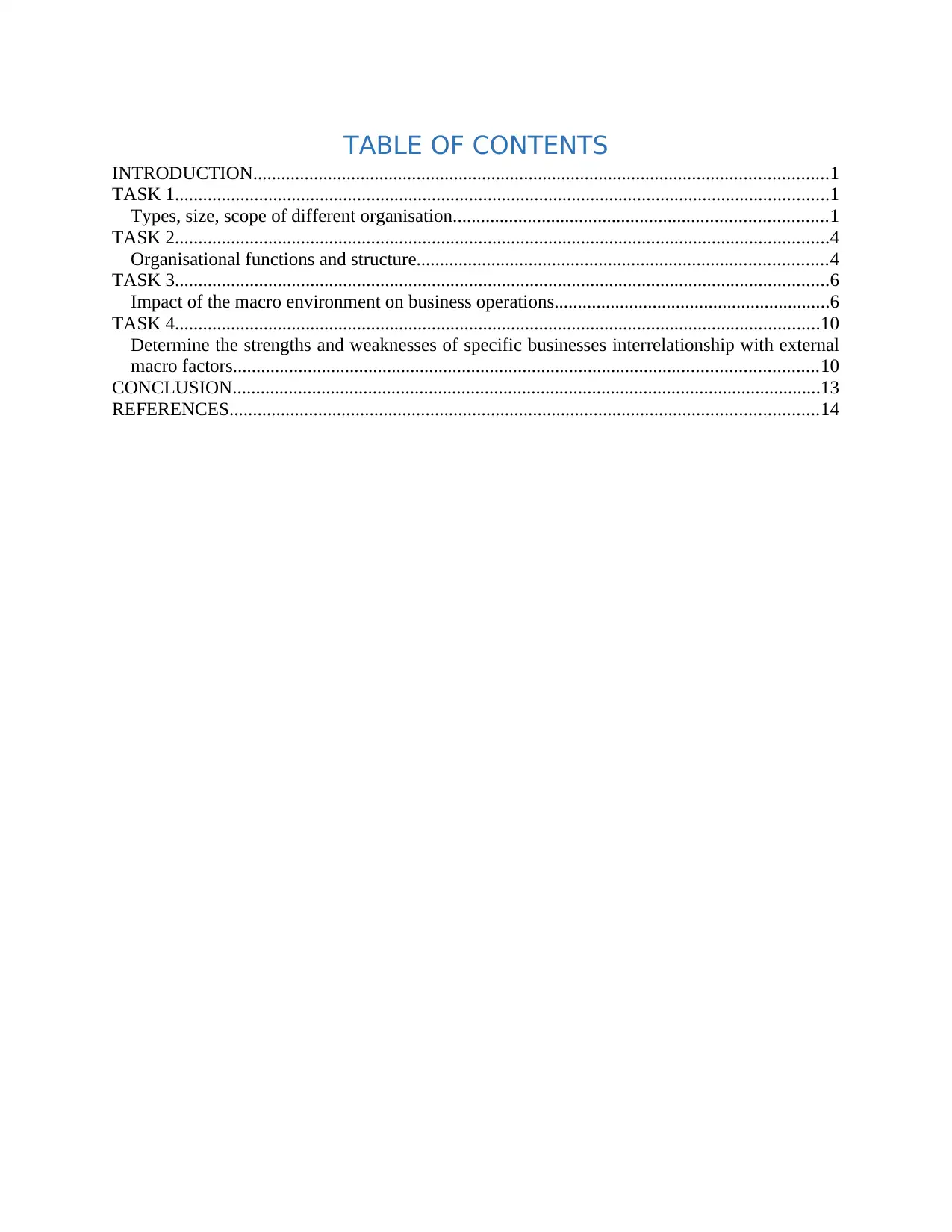
TABLE OF CONTENTS
INTRODUCTION...........................................................................................................................1
TASK 1............................................................................................................................................1
Types, size, scope of different organisation................................................................................1
TASK 2............................................................................................................................................4
Organisational functions and structure........................................................................................4
TASK 3............................................................................................................................................6
Impact of the macro environment on business operations...........................................................6
TASK 4..........................................................................................................................................10
Determine the strengths and weaknesses of specific businesses interrelationship with external
macro factors.............................................................................................................................10
CONCLUSION..............................................................................................................................13
REFERENCES..............................................................................................................................14
INTRODUCTION...........................................................................................................................1
TASK 1............................................................................................................................................1
Types, size, scope of different organisation................................................................................1
TASK 2............................................................................................................................................4
Organisational functions and structure........................................................................................4
TASK 3............................................................................................................................................6
Impact of the macro environment on business operations...........................................................6
TASK 4..........................................................................................................................................10
Determine the strengths and weaknesses of specific businesses interrelationship with external
macro factors.............................................................................................................................10
CONCLUSION..............................................................................................................................13
REFERENCES..............................................................................................................................14

INTRODUCTION
Organisation function is the centre of activities which are carried out by an entity to
enhance the overall growth and development. There are many common activities like marketing,
resource development, technology related strategies, customers’ policies, and management which
are included as functions for the organisation. This assignment will be going to cover different
sectors of organisations, their size, legal structure, scope, etc. and how the organisational
structures are related to their functions in order to achieve the goals and objectives. It will also
include about PESTLE analysis of Lego to understand the micro environment and its impact on
the business operations with respect to their current status by measuring factors like economic,
environmental, legal etc. Furthermore, SWOT Analysis will also be done to identify the strengths
and weaknesses of an organisation to recognise their threats and opportunities as well.
TASK 1
Types, size, scope of different organisation.
There are three types of organisation public, private voluntary organisation. All of these can be
distinguish according to their legal structure, scope, size, structure and vision.
Types of different organisations
Lego (private organisation): as Lego is a construction based organisation, this entity uses top
manufacture plastic bricks and wooden toys and many more plastic related appliances (Nielsen,
Schneider and Trifiletti, 2017). As it is a private company, so its main motive is to supply their
products over global level and generate high revenue for their firm.
UNICEF (voluntary organisation): this entity is a human funding centred organisation, which
provides its services to most of the children and mothers in developing countries (UNICEF,
2014). With a good intension, in order to improve the conditions of children's in most of the
areas.
Bank of England (public organisation): this is a central bank of United Kingdom. This
company’s main features are to monitor the stable prices as well as currency in order to maintain
the financial stability. it was a privately based organisation till 1694 than it turned to public
organisation which was totally owned by the government in 1988. public services include
military, construction of buildings, tunnels, sewers and etc.
Size of different organisation
1
Organisation function is the centre of activities which are carried out by an entity to
enhance the overall growth and development. There are many common activities like marketing,
resource development, technology related strategies, customers’ policies, and management which
are included as functions for the organisation. This assignment will be going to cover different
sectors of organisations, their size, legal structure, scope, etc. and how the organisational
structures are related to their functions in order to achieve the goals and objectives. It will also
include about PESTLE analysis of Lego to understand the micro environment and its impact on
the business operations with respect to their current status by measuring factors like economic,
environmental, legal etc. Furthermore, SWOT Analysis will also be done to identify the strengths
and weaknesses of an organisation to recognise their threats and opportunities as well.
TASK 1
Types, size, scope of different organisation.
There are three types of organisation public, private voluntary organisation. All of these can be
distinguish according to their legal structure, scope, size, structure and vision.
Types of different organisations
Lego (private organisation): as Lego is a construction based organisation, this entity uses top
manufacture plastic bricks and wooden toys and many more plastic related appliances (Nielsen,
Schneider and Trifiletti, 2017). As it is a private company, so its main motive is to supply their
products over global level and generate high revenue for their firm.
UNICEF (voluntary organisation): this entity is a human funding centred organisation, which
provides its services to most of the children and mothers in developing countries (UNICEF,
2014). With a good intension, in order to improve the conditions of children's in most of the
areas.
Bank of England (public organisation): this is a central bank of United Kingdom. This
company’s main features are to monitor the stable prices as well as currency in order to maintain
the financial stability. it was a privately based organisation till 1694 than it turned to public
organisation which was totally owned by the government in 1988. public services include
military, construction of buildings, tunnels, sewers and etc.
Size of different organisation
1
⊘ This is a preview!⊘
Do you want full access?
Subscribe today to unlock all pages.

Trusted by 1+ million students worldwide
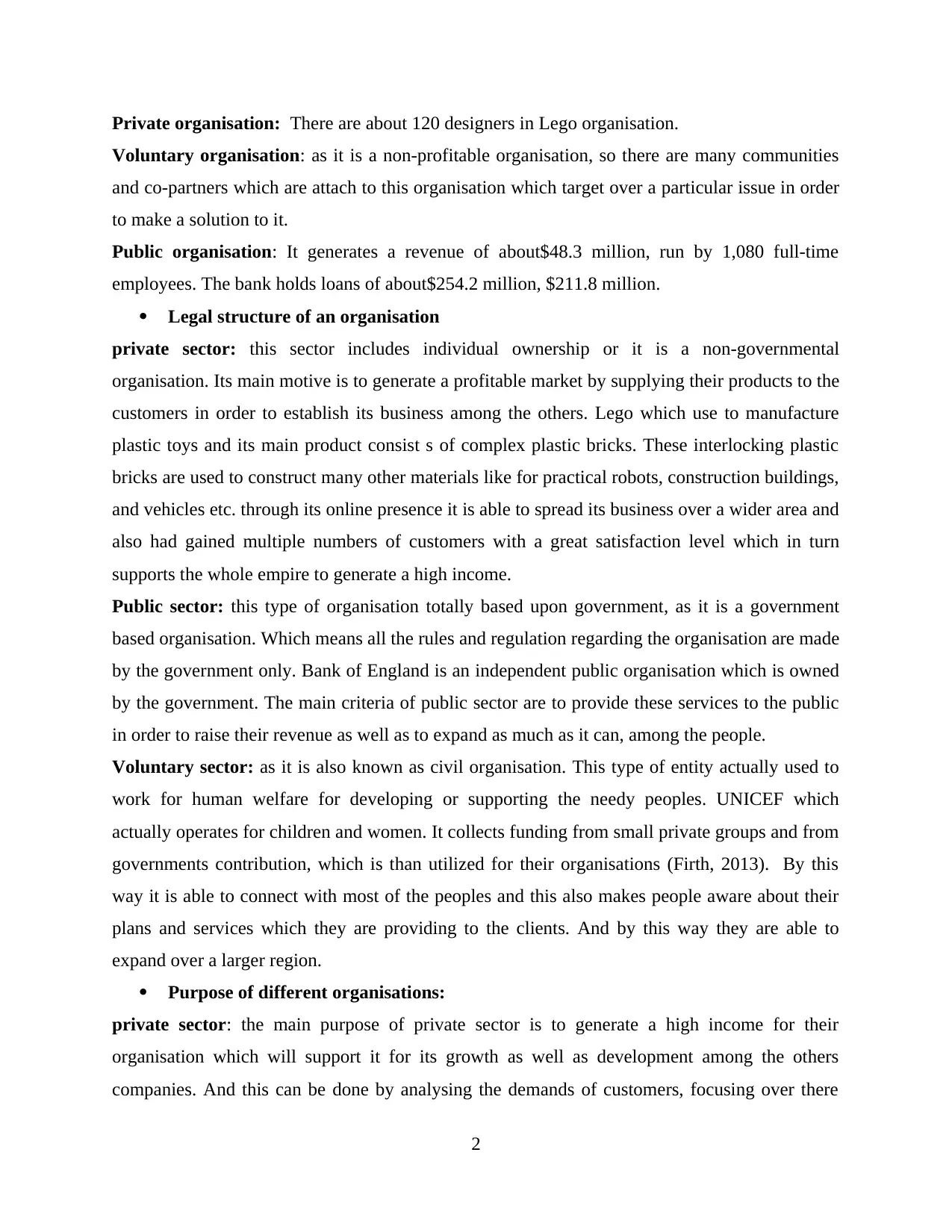
Private organisation: There are about 120 designers in Lego organisation.
Voluntary organisation: as it is a non-profitable organisation, so there are many communities
and co-partners which are attach to this organisation which target over a particular issue in order
to make a solution to it.
Public organisation: It generates a revenue of about$48.3 million, run by 1,080 full-time
employees. The bank holds loans of about$254.2 million, $211.8 million.
Legal structure of an organisation
private sector: this sector includes individual ownership or it is a non-governmental
organisation. Its main motive is to generate a profitable market by supplying their products to the
customers in order to establish its business among the others. Lego which use to manufacture
plastic toys and its main product consist s of complex plastic bricks. These interlocking plastic
bricks are used to construct many other materials like for practical robots, construction buildings,
and vehicles etc. through its online presence it is able to spread its business over a wider area and
also had gained multiple numbers of customers with a great satisfaction level which in turn
supports the whole empire to generate a high income.
Public sector: this type of organisation totally based upon government, as it is a government
based organisation. Which means all the rules and regulation regarding the organisation are made
by the government only. Bank of England is an independent public organisation which is owned
by the government. The main criteria of public sector are to provide these services to the public
in order to raise their revenue as well as to expand as much as it can, among the people.
Voluntary sector: as it is also known as civil organisation. This type of entity actually used to
work for human welfare for developing or supporting the needy peoples. UNICEF which
actually operates for children and women. It collects funding from small private groups and from
governments contribution, which is than utilized for their organisations (Firth, 2013). By this
way it is able to connect with most of the peoples and this also makes people aware about their
plans and services which they are providing to the clients. And by this way they are able to
expand over a larger region.
Purpose of different organisations:
private sector: the main purpose of private sector is to generate a high income for their
organisation which will support it for its growth as well as development among the others
companies. And this can be done by analysing the demands of customers, focusing over there
2
Voluntary organisation: as it is a non-profitable organisation, so there are many communities
and co-partners which are attach to this organisation which target over a particular issue in order
to make a solution to it.
Public organisation: It generates a revenue of about$48.3 million, run by 1,080 full-time
employees. The bank holds loans of about$254.2 million, $211.8 million.
Legal structure of an organisation
private sector: this sector includes individual ownership or it is a non-governmental
organisation. Its main motive is to generate a profitable market by supplying their products to the
customers in order to establish its business among the others. Lego which use to manufacture
plastic toys and its main product consist s of complex plastic bricks. These interlocking plastic
bricks are used to construct many other materials like for practical robots, construction buildings,
and vehicles etc. through its online presence it is able to spread its business over a wider area and
also had gained multiple numbers of customers with a great satisfaction level which in turn
supports the whole empire to generate a high income.
Public sector: this type of organisation totally based upon government, as it is a government
based organisation. Which means all the rules and regulation regarding the organisation are made
by the government only. Bank of England is an independent public organisation which is owned
by the government. The main criteria of public sector are to provide these services to the public
in order to raise their revenue as well as to expand as much as it can, among the people.
Voluntary sector: as it is also known as civil organisation. This type of entity actually used to
work for human welfare for developing or supporting the needy peoples. UNICEF which
actually operates for children and women. It collects funding from small private groups and from
governments contribution, which is than utilized for their organisations (Firth, 2013). By this
way it is able to connect with most of the peoples and this also makes people aware about their
plans and services which they are providing to the clients. And by this way they are able to
expand over a larger region.
Purpose of different organisations:
private sector: the main purpose of private sector is to generate a high income for their
organisation which will support it for its growth as well as development among the others
companies. And this can be done by analysing the demands of customers, focusing over there
2
Paraphrase This Document
Need a fresh take? Get an instant paraphrase of this document with our AI Paraphraser

taste and preferences and then manufacture the product according to that only. Lego which
belongs to a construction business had add many of the plastic toys to it which are liked by most
of the children’s, and this affects the firm a lot as it supports them to earn more and more profit
for their growth.
Voluntary sector: the main purpose of voluntary sector is to provide these services to most of
the cu8stomers in order to fill the requirement of needy people and also to expand as much as it
can. UNICEF (United Nations Children's Fund) focuses over developing community level as
well as health related issues of children's. It has many co-partners which are working for
different issues like educational supplies, HIV sufferings (mainly mothers and children's),
emergency shelter programs and etc.
public sector: As it is a governmental organisation, so its main purpose is to provide these
services to the public and to do a great expansion over a larger area by satisfying customers’
needs and demands in order to make profit. Bank of England has two main functions over which
it operates these are financial stability and asset purchase facility. By this way they are able to
spread globally and also have large numbers of customers within their organisation.
Scope of different organisation
Private: All though private firms have a risk factors, it still has a scope of sustaining in the
market for a longer time and also to expand internationally. and this can be proved by analysing
the current demands of customers and then process or manufacture their product according to
clients’ preferences (Baker, 2012). By satisfying the customers need and choices a company can
expand as well sustain for a longer duration in the market and can also create a profitable
relationship with the customers. Lego which is a construction based company has innovated
many of its products like video games, board games through which it is able to establish its
empire over a vast area.
Voluntary: with the support of small committees and other co-partners, UNICEF is able to
expand its empire over most of the location, with the help of promotional events as well as
fundraising. Through advertisement and organising health care programs it is able to make
people aware about its entity and their programs. Which would support them to communicate
with most of the religious communities.
3
belongs to a construction business had add many of the plastic toys to it which are liked by most
of the children’s, and this affects the firm a lot as it supports them to earn more and more profit
for their growth.
Voluntary sector: the main purpose of voluntary sector is to provide these services to most of
the cu8stomers in order to fill the requirement of needy people and also to expand as much as it
can. UNICEF (United Nations Children's Fund) focuses over developing community level as
well as health related issues of children's. It has many co-partners which are working for
different issues like educational supplies, HIV sufferings (mainly mothers and children's),
emergency shelter programs and etc.
public sector: As it is a governmental organisation, so its main purpose is to provide these
services to the public and to do a great expansion over a larger area by satisfying customers’
needs and demands in order to make profit. Bank of England has two main functions over which
it operates these are financial stability and asset purchase facility. By this way they are able to
spread globally and also have large numbers of customers within their organisation.
Scope of different organisation
Private: All though private firms have a risk factors, it still has a scope of sustaining in the
market for a longer time and also to expand internationally. and this can be proved by analysing
the current demands of customers and then process or manufacture their product according to
clients’ preferences (Baker, 2012). By satisfying the customers need and choices a company can
expand as well sustain for a longer duration in the market and can also create a profitable
relationship with the customers. Lego which is a construction based company has innovated
many of its products like video games, board games through which it is able to establish its
empire over a vast area.
Voluntary: with the support of small committees and other co-partners, UNICEF is able to
expand its empire over most of the location, with the help of promotional events as well as
fundraising. Through advertisement and organising health care programs it is able to make
people aware about its entity and their programs. Which would support them to communicate
with most of the religious communities.
3
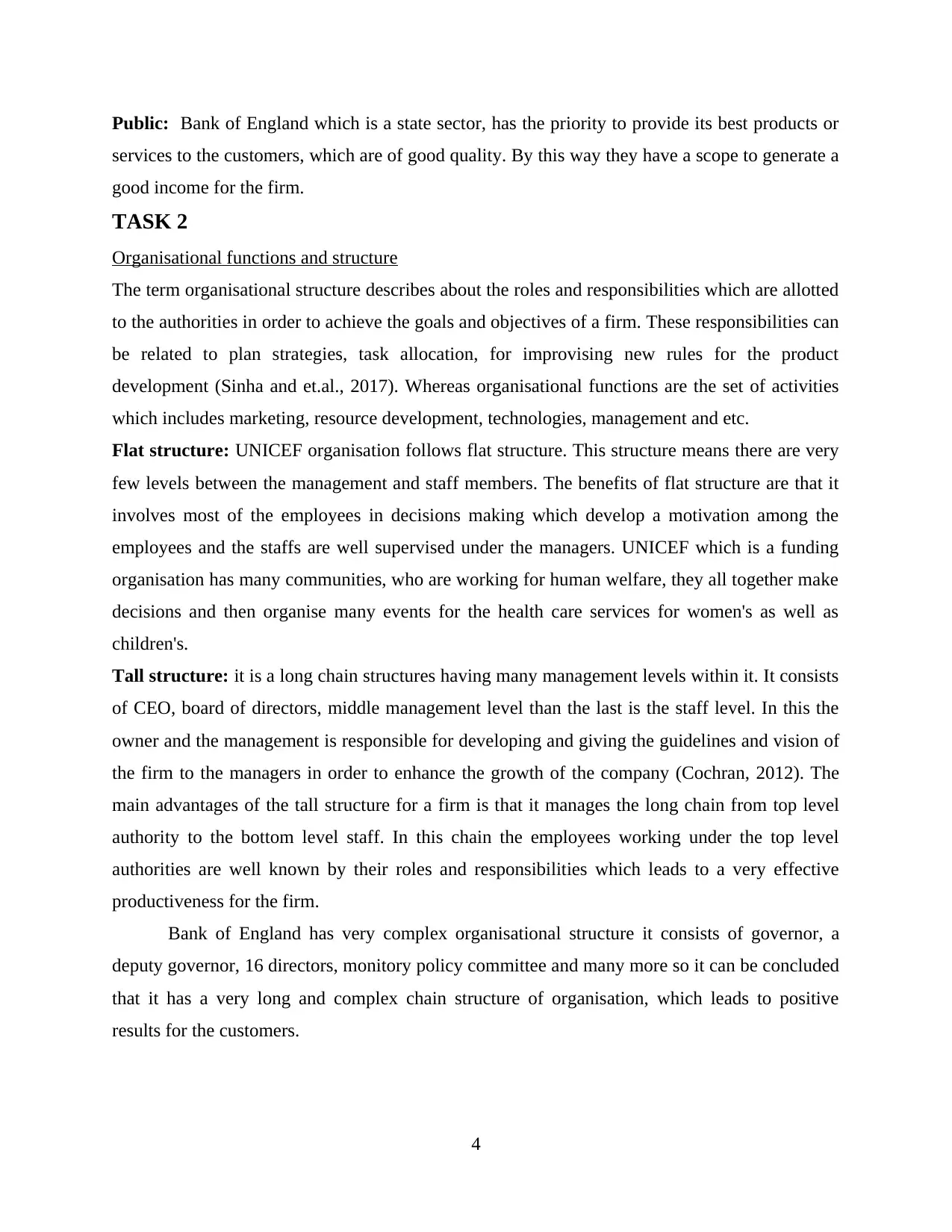
Public: Bank of England which is a state sector, has the priority to provide its best products or
services to the customers, which are of good quality. By this way they have a scope to generate a
good income for the firm.
TASK 2
Organisational functions and structure
The term organisational structure describes about the roles and responsibilities which are allotted
to the authorities in order to achieve the goals and objectives of a firm. These responsibilities can
be related to plan strategies, task allocation, for improvising new rules for the product
development (Sinha and et.al., 2017). Whereas organisational functions are the set of activities
which includes marketing, resource development, technologies, management and etc.
Flat structure: UNICEF organisation follows flat structure. This structure means there are very
few levels between the management and staff members. The benefits of flat structure are that it
involves most of the employees in decisions making which develop a motivation among the
employees and the staffs are well supervised under the managers. UNICEF which is a funding
organisation has many communities, who are working for human welfare, they all together make
decisions and then organise many events for the health care services for women's as well as
children's.
Tall structure: it is a long chain structures having many management levels within it. It consists
of CEO, board of directors, middle management level than the last is the staff level. In this the
owner and the management is responsible for developing and giving the guidelines and vision of
the firm to the managers in order to enhance the growth of the company (Cochran, 2012). The
main advantages of the tall structure for a firm is that it manages the long chain from top level
authority to the bottom level staff. In this chain the employees working under the top level
authorities are well known by their roles and responsibilities which leads to a very effective
productiveness for the firm.
Bank of England has very complex organisational structure it consists of governor, a
deputy governor, 16 directors, monitory policy committee and many more so it can be concluded
that it has a very long and complex chain structure of organisation, which leads to positive
results for the customers.
4
services to the customers, which are of good quality. By this way they have a scope to generate a
good income for the firm.
TASK 2
Organisational functions and structure
The term organisational structure describes about the roles and responsibilities which are allotted
to the authorities in order to achieve the goals and objectives of a firm. These responsibilities can
be related to plan strategies, task allocation, for improvising new rules for the product
development (Sinha and et.al., 2017). Whereas organisational functions are the set of activities
which includes marketing, resource development, technologies, management and etc.
Flat structure: UNICEF organisation follows flat structure. This structure means there are very
few levels between the management and staff members. The benefits of flat structure are that it
involves most of the employees in decisions making which develop a motivation among the
employees and the staffs are well supervised under the managers. UNICEF which is a funding
organisation has many communities, who are working for human welfare, they all together make
decisions and then organise many events for the health care services for women's as well as
children's.
Tall structure: it is a long chain structures having many management levels within it. It consists
of CEO, board of directors, middle management level than the last is the staff level. In this the
owner and the management is responsible for developing and giving the guidelines and vision of
the firm to the managers in order to enhance the growth of the company (Cochran, 2012). The
main advantages of the tall structure for a firm is that it manages the long chain from top level
authority to the bottom level staff. In this chain the employees working under the top level
authorities are well known by their roles and responsibilities which leads to a very effective
productiveness for the firm.
Bank of England has very complex organisational structure it consists of governor, a
deputy governor, 16 directors, monitory policy committee and many more so it can be concluded
that it has a very long and complex chain structure of organisation, which leads to positive
results for the customers.
4
⊘ This is a preview!⊘
Do you want full access?
Subscribe today to unlock all pages.

Trusted by 1+ million students worldwide
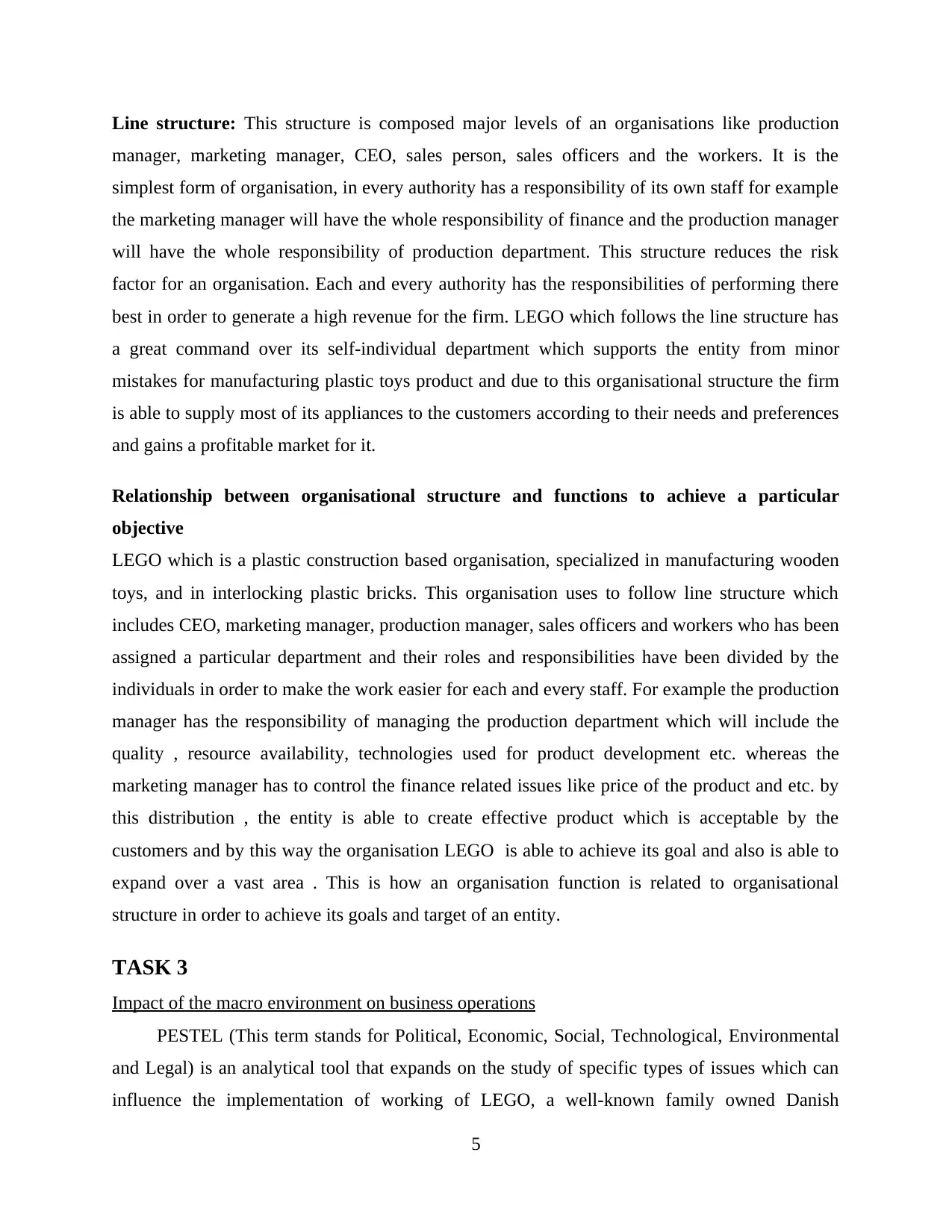
Line structure: This structure is composed major levels of an organisations like production
manager, marketing manager, CEO, sales person, sales officers and the workers. It is the
simplest form of organisation, in every authority has a responsibility of its own staff for example
the marketing manager will have the whole responsibility of finance and the production manager
will have the whole responsibility of production department. This structure reduces the risk
factor for an organisation. Each and every authority has the responsibilities of performing there
best in order to generate a high revenue for the firm. LEGO which follows the line structure has
a great command over its self-individual department which supports the entity from minor
mistakes for manufacturing plastic toys product and due to this organisational structure the firm
is able to supply most of its appliances to the customers according to their needs and preferences
and gains a profitable market for it.
Relationship between organisational structure and functions to achieve a particular
objective
LEGO which is a plastic construction based organisation, specialized in manufacturing wooden
toys, and in interlocking plastic bricks. This organisation uses to follow line structure which
includes CEO, marketing manager, production manager, sales officers and workers who has been
assigned a particular department and their roles and responsibilities have been divided by the
individuals in order to make the work easier for each and every staff. For example the production
manager has the responsibility of managing the production department which will include the
quality , resource availability, technologies used for product development etc. whereas the
marketing manager has to control the finance related issues like price of the product and etc. by
this distribution , the entity is able to create effective product which is acceptable by the
customers and by this way the organisation LEGO is able to achieve its goal and also is able to
expand over a vast area . This is how an organisation function is related to organisational
structure in order to achieve its goals and target of an entity.
TASK 3
Impact of the macro environment on business operations
PESTEL (This term stands for Political, Economic, Social, Technological, Environmental
and Legal) is an analytical tool that expands on the study of specific types of issues which can
influence the implementation of working of LEGO, a well-known family owned Danish
5
manager, marketing manager, CEO, sales person, sales officers and the workers. It is the
simplest form of organisation, in every authority has a responsibility of its own staff for example
the marketing manager will have the whole responsibility of finance and the production manager
will have the whole responsibility of production department. This structure reduces the risk
factor for an organisation. Each and every authority has the responsibilities of performing there
best in order to generate a high revenue for the firm. LEGO which follows the line structure has
a great command over its self-individual department which supports the entity from minor
mistakes for manufacturing plastic toys product and due to this organisational structure the firm
is able to supply most of its appliances to the customers according to their needs and preferences
and gains a profitable market for it.
Relationship between organisational structure and functions to achieve a particular
objective
LEGO which is a plastic construction based organisation, specialized in manufacturing wooden
toys, and in interlocking plastic bricks. This organisation uses to follow line structure which
includes CEO, marketing manager, production manager, sales officers and workers who has been
assigned a particular department and their roles and responsibilities have been divided by the
individuals in order to make the work easier for each and every staff. For example the production
manager has the responsibility of managing the production department which will include the
quality , resource availability, technologies used for product development etc. whereas the
marketing manager has to control the finance related issues like price of the product and etc. by
this distribution , the entity is able to create effective product which is acceptable by the
customers and by this way the organisation LEGO is able to achieve its goal and also is able to
expand over a vast area . This is how an organisation function is related to organisational
structure in order to achieve its goals and target of an entity.
TASK 3
Impact of the macro environment on business operations
PESTEL (This term stands for Political, Economic, Social, Technological, Environmental
and Legal) is an analytical tool that expands on the study of specific types of issues which can
influence the implementation of working of LEGO, a well-known family owned Danish
5
Paraphrase This Document
Need a fresh take? Get an instant paraphrase of this document with our AI Paraphraser
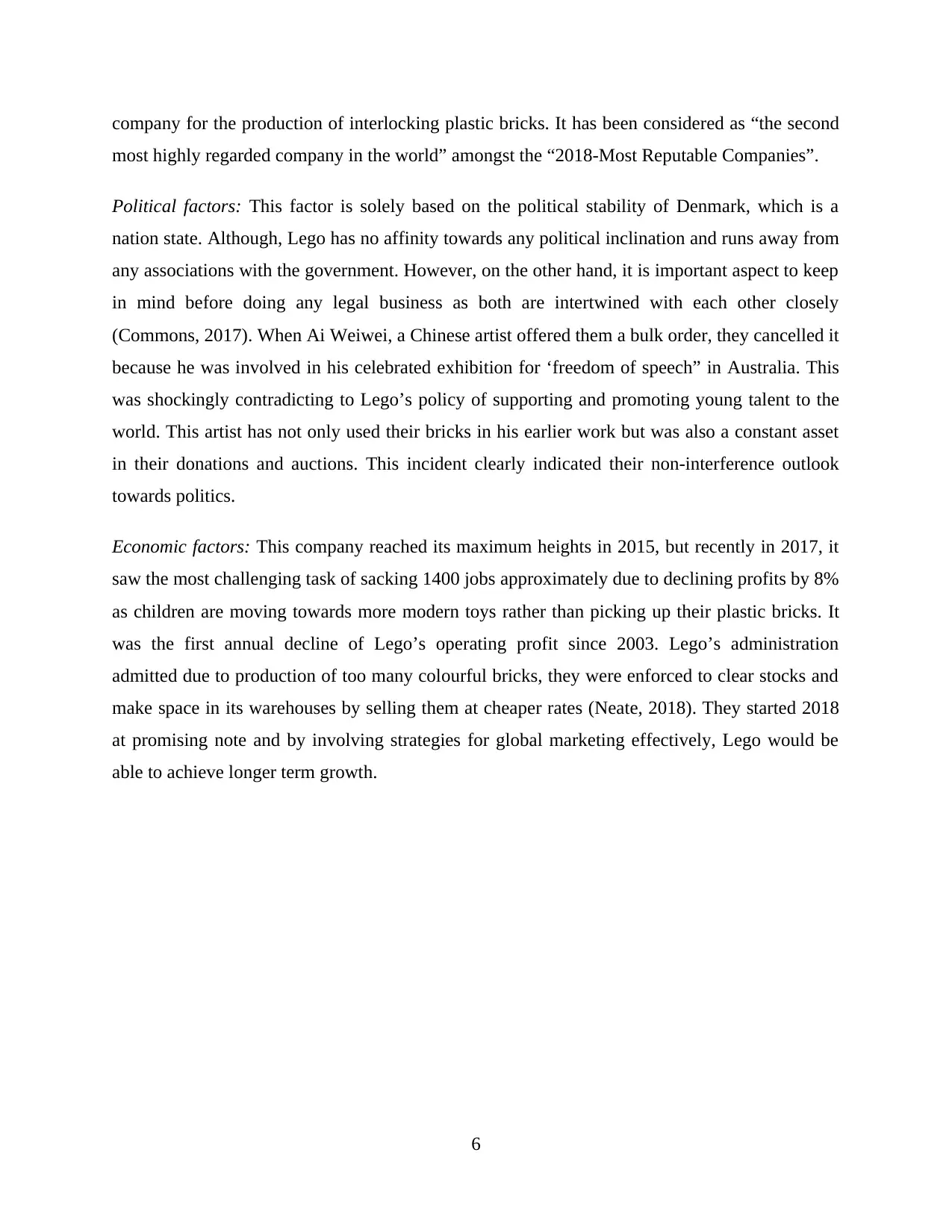
company for the production of interlocking plastic bricks. It has been considered as “the second
most highly regarded company in the world” amongst the “2018-Most Reputable Companies”.
Political factors: This factor is solely based on the political stability of Denmark, which is a
nation state. Although, Lego has no affinity towards any political inclination and runs away from
any associations with the government. However, on the other hand, it is important aspect to keep
in mind before doing any legal business as both are intertwined with each other closely
(Commons, 2017). When Ai Weiwei, a Chinese artist offered them a bulk order, they cancelled it
because he was involved in his celebrated exhibition for ‘freedom of speech” in Australia. This
was shockingly contradicting to Lego’s policy of supporting and promoting young talent to the
world. This artist has not only used their bricks in his earlier work but was also a constant asset
in their donations and auctions. This incident clearly indicated their non-interference outlook
towards politics.
Economic factors: This company reached its maximum heights in 2015, but recently in 2017, it
saw the most challenging task of sacking 1400 jobs approximately due to declining profits by 8%
as children are moving towards more modern toys rather than picking up their plastic bricks. It
was the first annual decline of Lego’s operating profit since 2003. Lego’s administration
admitted due to production of too many colourful bricks, they were enforced to clear stocks and
make space in its warehouses by selling them at cheaper rates (Neate, 2018). They started 2018
at promising note and by involving strategies for global marketing effectively, Lego would be
able to achieve longer term growth.
6
most highly regarded company in the world” amongst the “2018-Most Reputable Companies”.
Political factors: This factor is solely based on the political stability of Denmark, which is a
nation state. Although, Lego has no affinity towards any political inclination and runs away from
any associations with the government. However, on the other hand, it is important aspect to keep
in mind before doing any legal business as both are intertwined with each other closely
(Commons, 2017). When Ai Weiwei, a Chinese artist offered them a bulk order, they cancelled it
because he was involved in his celebrated exhibition for ‘freedom of speech” in Australia. This
was shockingly contradicting to Lego’s policy of supporting and promoting young talent to the
world. This artist has not only used their bricks in his earlier work but was also a constant asset
in their donations and auctions. This incident clearly indicated their non-interference outlook
towards politics.
Economic factors: This company reached its maximum heights in 2015, but recently in 2017, it
saw the most challenging task of sacking 1400 jobs approximately due to declining profits by 8%
as children are moving towards more modern toys rather than picking up their plastic bricks. It
was the first annual decline of Lego’s operating profit since 2003. Lego’s administration
admitted due to production of too many colourful bricks, they were enforced to clear stocks and
make space in its warehouses by selling them at cheaper rates (Neate, 2018). They started 2018
at promising note and by involving strategies for global marketing effectively, Lego would be
able to achieve longer term growth.
6

Figure 1: Lego’s brick toy box
(Source: Building Legos, 2018)
Social factors: It is almost 70 years that this company is involved with kids ranging from 3 years
to 15 years. Lego believed that a child’s psychological and rational development must be
determined by the opportunities, exposure and activities like sports, drama etc. they perform at
young age for the overall growth of creative and cognitive thinking. Being a global leader, it is
their prime responsibility to generate awareness about child’s welfare by taking initiatives,
providing donations etc. Lego has collaborated with UNICEF (United Nations Children's Fund)
to protect and safeguard children rights and assist in the elimination of societal evils such as
child abuse, child labour, harassment and many more. They always have a coherent approach
towards their education, growth and well-being as children are the pillars of the future.
Additionally, they have also drawn attention towards children who live in war zones and
promised to UNICEF a donation of 8.2 million dollars for their welfare projects.
Technological factors: Lego toys USP (Unique Selling Proposition) is to sell toys related to
construction with respect to an intrinsic detailing of each brick, which can be dismantled and re-
constructed multiple times with thousands of permutation and combination existing possibilities.
It is popularly called as Apple of toy industry, due to its immense contribution in creative
7
(Source: Building Legos, 2018)
Social factors: It is almost 70 years that this company is involved with kids ranging from 3 years
to 15 years. Lego believed that a child’s psychological and rational development must be
determined by the opportunities, exposure and activities like sports, drama etc. they perform at
young age for the overall growth of creative and cognitive thinking. Being a global leader, it is
their prime responsibility to generate awareness about child’s welfare by taking initiatives,
providing donations etc. Lego has collaborated with UNICEF (United Nations Children's Fund)
to protect and safeguard children rights and assist in the elimination of societal evils such as
child abuse, child labour, harassment and many more. They always have a coherent approach
towards their education, growth and well-being as children are the pillars of the future.
Additionally, they have also drawn attention towards children who live in war zones and
promised to UNICEF a donation of 8.2 million dollars for their welfare projects.
Technological factors: Lego toys USP (Unique Selling Proposition) is to sell toys related to
construction with respect to an intrinsic detailing of each brick, which can be dismantled and re-
constructed multiple times with thousands of permutation and combination existing possibilities.
It is popularly called as Apple of toy industry, due to its immense contribution in creative
7
⊘ This is a preview!⊘
Do you want full access?
Subscribe today to unlock all pages.

Trusted by 1+ million students worldwide
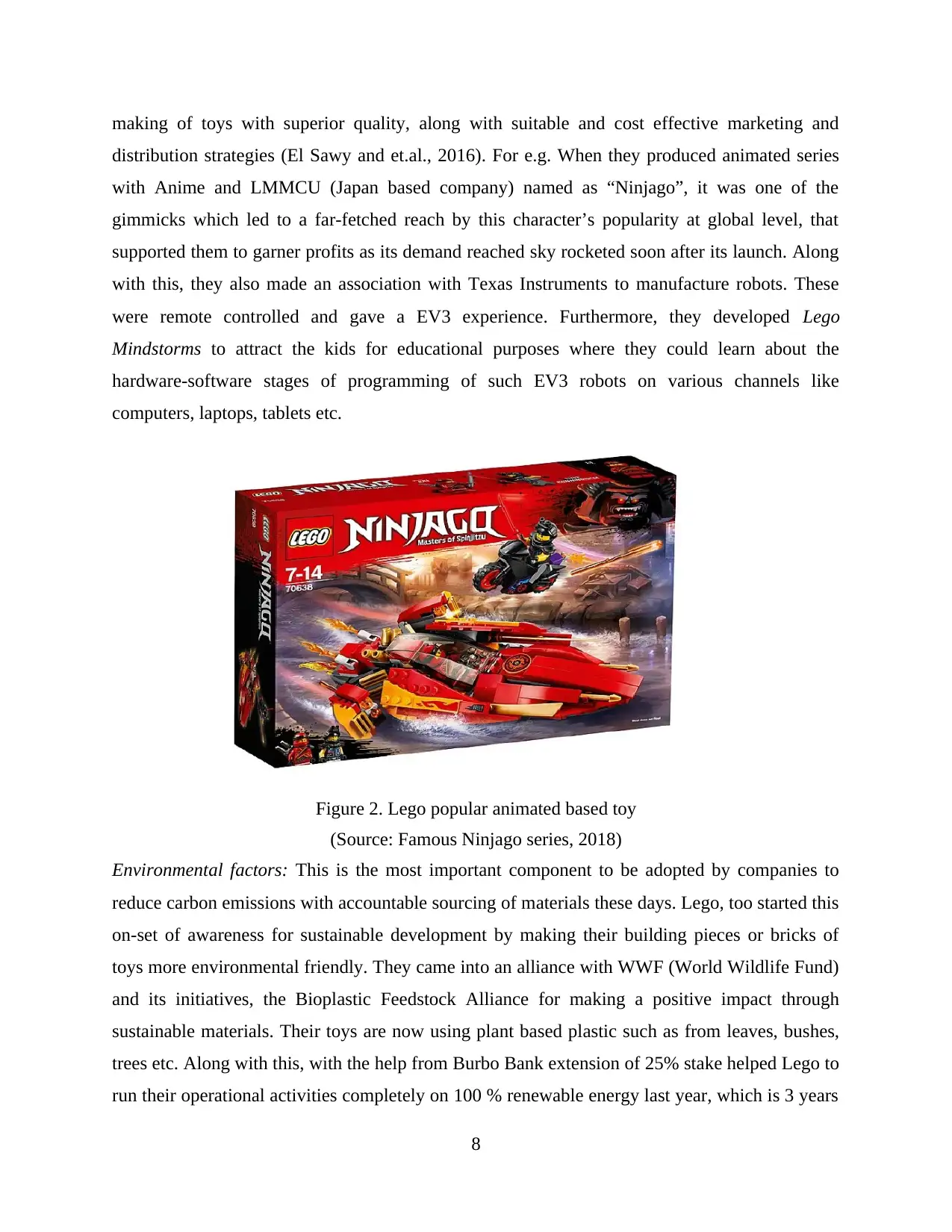
making of toys with superior quality, along with suitable and cost effective marketing and
distribution strategies (El Sawy and et.al., 2016). For e.g. When they produced animated series
with Anime and LMMCU (Japan based company) named as “Ninjago”, it was one of the
gimmicks which led to a far-fetched reach by this character’s popularity at global level, that
supported them to garner profits as its demand reached sky rocketed soon after its launch. Along
with this, they also made an association with Texas Instruments to manufacture robots. These
were remote controlled and gave a EV3 experience. Furthermore, they developed Lego
Mindstorms to attract the kids for educational purposes where they could learn about the
hardware-software stages of programming of such EV3 robots on various channels like
computers, laptops, tablets etc.
Figure 2. Lego popular animated based toy
(Source: Famous Ninjago series, 2018)
Environmental factors: This is the most important component to be adopted by companies to
reduce carbon emissions with accountable sourcing of materials these days. Lego, too started this
on-set of awareness for sustainable development by making their building pieces or bricks of
toys more environmental friendly. They came into an alliance with WWF (World Wildlife Fund)
and its initiatives, the Bioplastic Feedstock Alliance for making a positive impact through
sustainable materials. Their toys are now using plant based plastic such as from leaves, bushes,
trees etc. Along with this, with the help from Burbo Bank extension of 25% stake helped Lego to
run their operational activities completely on 100 % renewable energy last year, which is 3 years
8
distribution strategies (El Sawy and et.al., 2016). For e.g. When they produced animated series
with Anime and LMMCU (Japan based company) named as “Ninjago”, it was one of the
gimmicks which led to a far-fetched reach by this character’s popularity at global level, that
supported them to garner profits as its demand reached sky rocketed soon after its launch. Along
with this, they also made an association with Texas Instruments to manufacture robots. These
were remote controlled and gave a EV3 experience. Furthermore, they developed Lego
Mindstorms to attract the kids for educational purposes where they could learn about the
hardware-software stages of programming of such EV3 robots on various channels like
computers, laptops, tablets etc.
Figure 2. Lego popular animated based toy
(Source: Famous Ninjago series, 2018)
Environmental factors: This is the most important component to be adopted by companies to
reduce carbon emissions with accountable sourcing of materials these days. Lego, too started this
on-set of awareness for sustainable development by making their building pieces or bricks of
toys more environmental friendly. They came into an alliance with WWF (World Wildlife Fund)
and its initiatives, the Bioplastic Feedstock Alliance for making a positive impact through
sustainable materials. Their toys are now using plant based plastic such as from leaves, bushes,
trees etc. Along with this, with the help from Burbo Bank extension of 25% stake helped Lego to
run their operational activities completely on 100 % renewable energy last year, which is 3 years
8
Paraphrase This Document
Need a fresh take? Get an instant paraphrase of this document with our AI Paraphraser
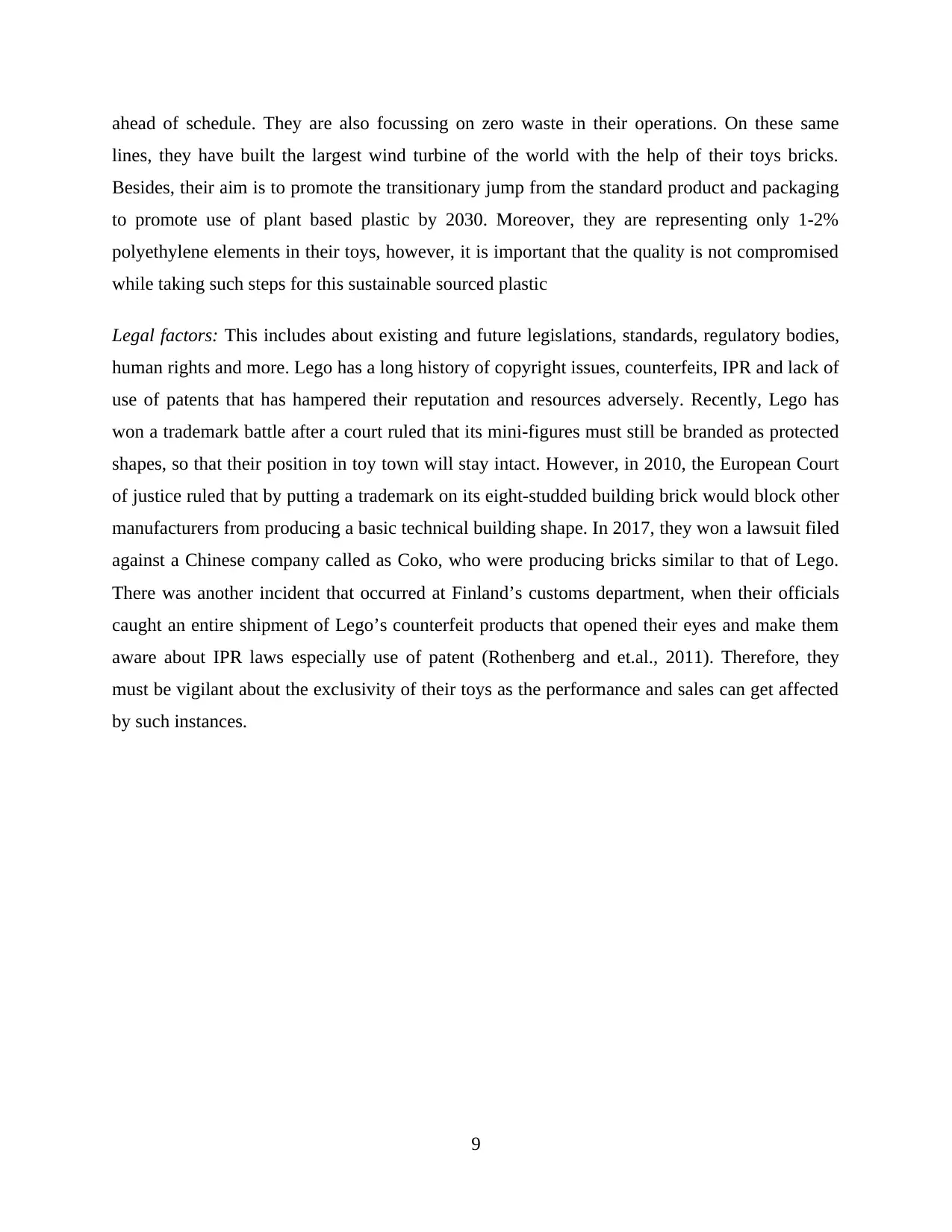
ahead of schedule. They are also focussing on zero waste in their operations. On these same
lines, they have built the largest wind turbine of the world with the help of their toys bricks.
Besides, their aim is to promote the transitionary jump from the standard product and packaging
to promote use of plant based plastic by 2030. Moreover, they are representing only 1-2%
polyethylene elements in their toys, however, it is important that the quality is not compromised
while taking such steps for this sustainable sourced plastic
Legal factors: This includes about existing and future legislations, standards, regulatory bodies,
human rights and more. Lego has a long history of copyright issues, counterfeits, IPR and lack of
use of patents that has hampered their reputation and resources adversely. Recently, Lego has
won a trademark battle after a court ruled that its mini-figures must still be branded as protected
shapes, so that their position in toy town will stay intact. However, in 2010, the European Court
of justice ruled that by putting a trademark on its eight-studded building brick would block other
manufacturers from producing a basic technical building shape. In 2017, they won a lawsuit filed
against a Chinese company called as Coko, who were producing bricks similar to that of Lego.
There was another incident that occurred at Finland’s customs department, when their officials
caught an entire shipment of Lego’s counterfeit products that opened their eyes and make them
aware about IPR laws especially use of patent (Rothenberg and et.al., 2011). Therefore, they
must be vigilant about the exclusivity of their toys as the performance and sales can get affected
by such instances.
9
lines, they have built the largest wind turbine of the world with the help of their toys bricks.
Besides, their aim is to promote the transitionary jump from the standard product and packaging
to promote use of plant based plastic by 2030. Moreover, they are representing only 1-2%
polyethylene elements in their toys, however, it is important that the quality is not compromised
while taking such steps for this sustainable sourced plastic
Legal factors: This includes about existing and future legislations, standards, regulatory bodies,
human rights and more. Lego has a long history of copyright issues, counterfeits, IPR and lack of
use of patents that has hampered their reputation and resources adversely. Recently, Lego has
won a trademark battle after a court ruled that its mini-figures must still be branded as protected
shapes, so that their position in toy town will stay intact. However, in 2010, the European Court
of justice ruled that by putting a trademark on its eight-studded building brick would block other
manufacturers from producing a basic technical building shape. In 2017, they won a lawsuit filed
against a Chinese company called as Coko, who were producing bricks similar to that of Lego.
There was another incident that occurred at Finland’s customs department, when their officials
caught an entire shipment of Lego’s counterfeit products that opened their eyes and make them
aware about IPR laws especially use of patent (Rothenberg and et.al., 2011). Therefore, they
must be vigilant about the exclusivity of their toys as the performance and sales can get affected
by such instances.
9
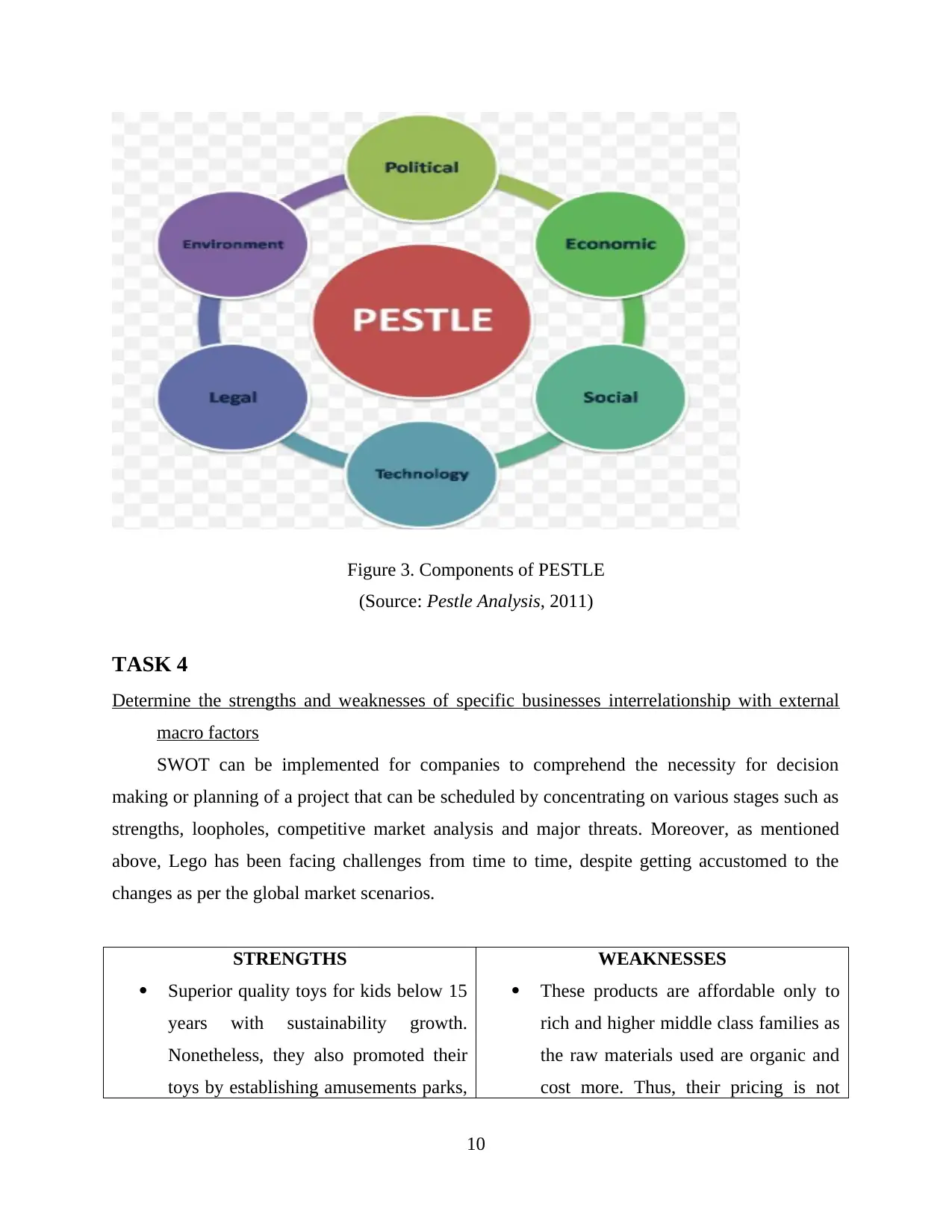
Figure 3. Components of PESTLE
(Source: Pestle Analysis, 2011)
TASK 4
Determine the strengths and weaknesses of specific businesses interrelationship with external
macro factors
SWOT can be implemented for companies to comprehend the necessity for decision
making or planning of a project that can be scheduled by concentrating on various stages such as
strengths, loopholes, competitive market analysis and major threats. Moreover, as mentioned
above, Lego has been facing challenges from time to time, despite getting accustomed to the
changes as per the global market scenarios.
STRENGTHS
Superior quality toys for kids below 15
years with sustainability growth.
Nonetheless, they also promoted their
toys by establishing amusements parks,
WEAKNESSES
These products are affordable only to
rich and higher middle class families as
the raw materials used are organic and
cost more. Thus, their pricing is not
10
(Source: Pestle Analysis, 2011)
TASK 4
Determine the strengths and weaknesses of specific businesses interrelationship with external
macro factors
SWOT can be implemented for companies to comprehend the necessity for decision
making or planning of a project that can be scheduled by concentrating on various stages such as
strengths, loopholes, competitive market analysis and major threats. Moreover, as mentioned
above, Lego has been facing challenges from time to time, despite getting accustomed to the
changes as per the global market scenarios.
STRENGTHS
Superior quality toys for kids below 15
years with sustainability growth.
Nonetheless, they also promoted their
toys by establishing amusements parks,
WEAKNESSES
These products are affordable only to
rich and higher middle class families as
the raw materials used are organic and
cost more. Thus, their pricing is not
10
⊘ This is a preview!⊘
Do you want full access?
Subscribe today to unlock all pages.

Trusted by 1+ million students worldwide
1 out of 17
Related Documents
Your All-in-One AI-Powered Toolkit for Academic Success.
+13062052269
info@desklib.com
Available 24*7 on WhatsApp / Email
![[object Object]](/_next/static/media/star-bottom.7253800d.svg)
Unlock your academic potential
Copyright © 2020–2025 A2Z Services. All Rights Reserved. Developed and managed by ZUCOL.





